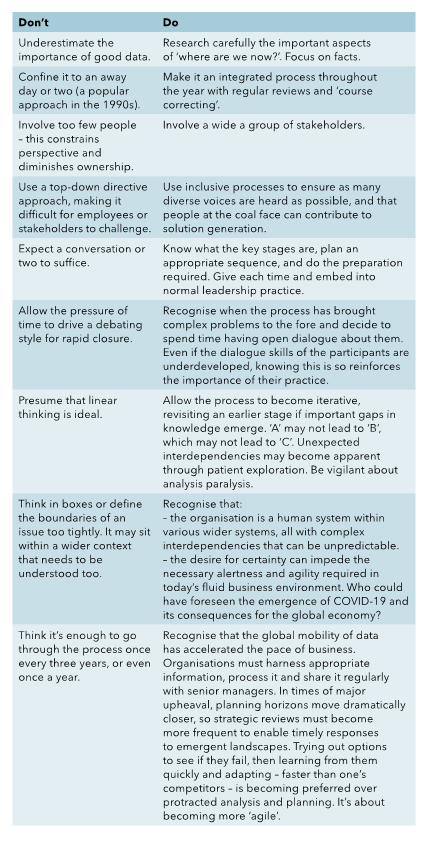Siobhan Soraghan of Active Insight Consulting Limited explains the three main strategy questions that can be applied to individuals and organisations to enhance their strategic decision-making capabilities.

Many moons ago, as a young MBA graduate, I was asked this simple question at an important interview: “So, what is strategy”? A surge of panic struck. The strategic management course had been one of my favourites. We had covered many tools to address this – industry analysis, competitive groupings, models for assessing corporate culture … I was soon to discover that I had gained a distinction for my paper on managing strategic change.
Yet in that moment, my brain flooded with the copious materials we’d covered. I stalled, unable to see the wood for the trees. The succinct answer only became clear to me on my way home. Lesson learned – don’t get lost in the tools and methodologies of strategy, keep in mind its simple core purpose. Hopefully this article, written with several decades of real life under my belt, will help you do that too.
So, what is the answer I might have given? Quite simply, strategy is about generating good answers to the following three questions: These questions can be applied to an individual or a team just as much as an organisation, as I have since experienced in my parallel role as a leadership coach. They are predicated on the fact that there is a gap between where you are now and where you want to get to. It could be a drive to manifest unrealised potential or to respond to some external force. The essence of strategy is very simple – but perhaps deceptively so. Arriving at a good answer to any of the above is in fact quite a challenge. To begin with, at least make sure you address all three of the above questions.
Preferences, pitfalls and peers
In my early consulting years, I was drawn to the question “Where do you want to get to?”. I enjoyed helping clients play with scenarios that might help them prepare for the unexpected and challenge their comfort zones. They found this highly valuable, as it wasn’t thinking they’d naturally engage in.
I didn’t realise at the time that this was largely due to the fact that their thinking references were different to mine.
As I gained experience, including a stint on the board of a major national charity, I learned that we must not allow our natural thinking preferences to emphasise just one of the key strategy questions. Thinking preferences differ from person to person. Some people are naturally ‘big chunk’ thinkers who spot patterns and trends with ease. They tend to be future-focused, and enjoy hypothesising and visioning. They are likely to be tangential and creative, generating big-leap (but higher-risk) options when problem-solving. This is my personal preference.
Others are naturally ‘small chunk’ thinkers, preferring to be more focused on the practical realities around them, prioritising what is real and pragmatic. They are more likely to come up with solutions that build on what has gone before and generate risk-mitigated incremental change.
Both bring complementary talents to the three core questions. With mutual respect, they can work together to help craft strategies that are both more grounded and more enterprising than they might otherwise be. A predominance of one type inevitably means blind spots and imbalance. So, once you know your thinking preference, make sure you have peers around you with different preferences. Get them involved in addressing each of the three questions. Strategy is a team sport – I can’t stress how important it is to find thinking partners who are different to you.
Strategy is a team sport – I can’t stress how important it is to find thinking partners who are different to you.
Get equipped
There many models and lenses that can support a thorough appraisal of each of the three key questions. They can help mitigate any risk of imbalance or of groupthink should there be a predominance of one thinking type in the team. A good leader should ensure they and their team have a well-rounded armoury of tried-and-tested tools and models, and that they know how to use them. These include, for example, Porter’s 5 Forces, Strategic Maps, and The Cultural Web to name but a few.
The process
Formulation is the process that a leader and their people go through to address the questions that lie beneath the three core strategic questions:
Now
What is our relative competitive market position? What is happening to our traditional markets and are new markets emerging? What are our strengths and weaknesses as an organisation? What opportunities and threats do we face? Good data is crucial, so conducting relevant research becomes a necessary part of the formulation process.
Where
Who must we become to ensure longevity, regardless of our past and given how the world is evolving? If we don’t want to follow the fate of Kodak or Betamax, who do we want to be? And what will that look like? How convincing are you to your followers? Do you absolutely believe the vision to be attainable? Are you communicating the compelling reasons clearly enough to your people? Do they understand how this vision will enhance their lives in your organisation?
Good dialogue in the team is crucial to address all of the above questions. Developing these skills – which are quite different to debating skills – is important. Insider tip: this is an opportunity to gain competitive advantage, as so few management teams do true ‘dialogue’ well.
Next
Given the vision, what options are available to address the gap between it and the reality of where we are now? What are their merits and risks? What scenarios can we envisage? What do we need to be good at to achieve the vision? How can we leverage our natural strengths? Do we need to make changes to our people, structures and processes? What are the success factors for the changes we wish to make? What are our priorities in the short and medium term?
Good analysis and decision-making are crucial, as is leaders having the courage to stake colours to the mast and commit to a range of new actions and initiatives. This takes the organisation beyond the known and pushes it past the magnetic pull of analysis paralysis. This is greatly facilitated by the engagement of followers, who are typically far more creative than senior management about ways to make changes.
Why bother?
There is an underlying question – why do strategy? It’s pretty self-evident that the context for your organisation is far from static. If you aren’t paying attention to changes in the customer needs that your organisation exists to serve, the way those needs are met, and in the landscape of other players in your markets, your organisation runs the risk of becoming irrelevant. So, the purpose of strategy is to remain relevant, wanted and accessible in a changing world. The strategy formulation process is simply how the leaders choose the best path to achieve this.
In summary
- While strategy may be simple in concept, in practice it requires processes that are taken sufficiently seriously to be embedded in the fabric of how the organisation goes about its business.
- Each of the three questions benefits from being addressed by a diverse group of participants from across and beyond the organisation to avoid blind spots and allow creativity to emerge.
- The core questions require different sets of activities and skills – be savvy about these, invest in each set and learn to switch gears appropriately.
Hopefully you now have some appreciation of the what and why of strategy. Perhaps you’ve been inspired to look at how your organisation is going about it, with whom, and using what tools. I encourage you to explore further so that you can contribute constructively to your organisation’s effective adaptation to the changing world around it.
Dos and don’ts
The truth is there’s no one way to go about formulating strategy. Approaches vary in terms of the precise steps in the process, who’s involved, how frequently they’re engaged and how they’re engaged, and the tools used. No doubt influences include consultancies hired in the past, approaches gleaned from business school courses, or methods the leader witnessed in their previous employer. But here are some general guidelines to consider:
Publication information
This article by Siobhan Soraghan, Director, Active Insight Consulting Limited, appeared in the November 2020 edition of the ICAEW Business and Management Faculty magazine. Her recent webinar, Strategic thinking for senior professionals, is available on demand.
Latest research
The ICAEW Library & Information service provides full-text access to leading business, finance and management journals and key business eBooks. Further reading related to strategic decision making can be found through these below.
These articles and others are available below to logged-in ICAEW members and ACA students.
Online articles
The Library provides access to leading business, finance and management journals. These journals are available to logged-in ICAEW members, ACA students and other entitled users subject to suppliers' terms of use.
More support on business
Read our articles, eBooks, reports and guides on strategy, risk and innovation.
Strategy, risk and innovation hubeBooks on business strategy and planningCan't find what you're looking for?
The ICAEW Library can give you the right information from trustworthy, professional sources that aren't freely available online. Contact us for expert help with your enquiries and research.
-
Update History
- 11 Nov 2020 (12: 00 AM GMT)
- First published
- 06 Jul 2022 (12: 00 AM BST)
- Page updated with Latest research section, adding further reading on strategic decision making. These additional articles provide fresh insights, case studies and perspectives on this topic. Please note that the original article from 2020 has not undergone any review or updates.
